HIGHLIGHTS: NOVEMBER 8, 2024
• Reinforcing relationships in China
• What dairy trade might look like under new administration
• U.S. dairy exports come up big in September
• USDEC holds feed seminar in China
• Japan protein workshop draws a full house
• Colombia ingredients workshops continue
• USDEC meets with USTR on common names
• Seeking solutions to common name challenge in Europe
• Member opportunity! Cheese mission to Central America
• Market Summary: GDT prices jump
• Russia looks for more butter
• More than 200 October Export Guide updates
• Glanbia splits its nutritional business
• Company news: Lifeway, Danone, Edlong
Featured
USDEC strengthens relationships in China; delivers proposal to lower tariffs
A consistent theme that arises when talking about dairy exports to China is the need to show up—to be present in the market. It was a topic that emerged at this year’s spring board meeting when Madam Yu Lu, vice president of the China Chamber of Commerce of Import & Export of Foodstuffs, Native Produce & Animal By-Products (CFNA), addressed attendees (see Global Dairy eBrief, 4/19/24). This was one reason why USDEC sent a delegation on a June business development mission to China (see Global Dairy eBrief, 6/28/24). And it was a message conveyed again this week, when USDEC President and CEO Krysta Harden and Executive Vice President, Policy and Strategy, Jaime Castaneda traveled to Shanghai and Beijing as part of the U.S. Multi-Commodity Cooperators Mission to participate in the China International Import Expo (CIIE), the Seventh Global Dairy Conference, the U.S.-China Agricultural Trade Cooperation Forum and several meetings with Chinese officials.
Both Harden and Castaneda presented at CIIE and the Global Dairy Conference, highlighting the strengths of U.S. dairy, including its commitments to quality, food safety and sustainability. (As a testament to the value of showing up and spending the time to build relationships, CFNA actually invited Harden to speak at CIIE during the previous June mission.)
Harden also accepted the opportunity offered by CFNA for an interview with China Global Television Network (CGTN), the English-language news channel of China’s state-run television news agency. The interview focused on trade relations, sustainability and the future of dairy trade, while offering an opportunity to further raise U.S. dairy’s profile in China.
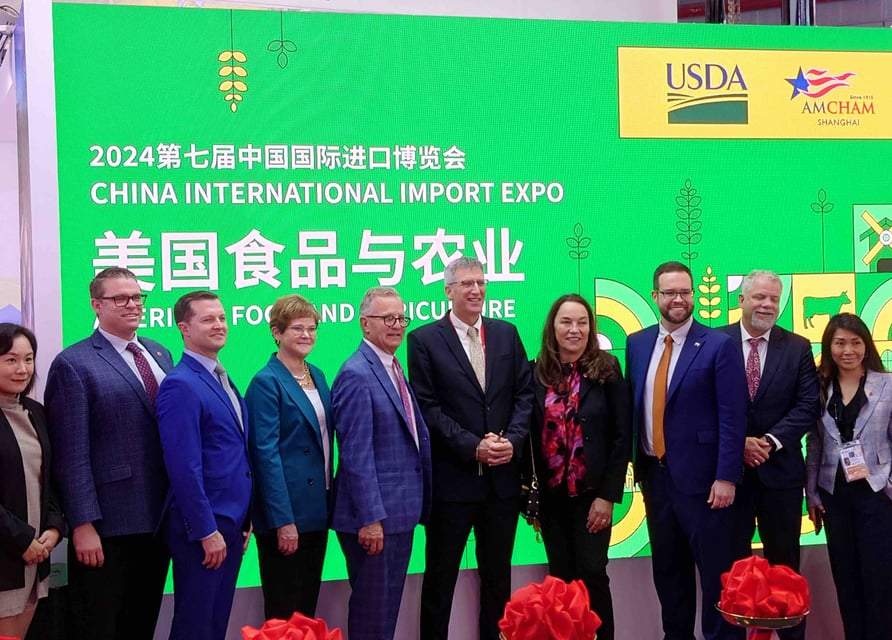
USDEC’s Krysta Harden joined with other USDA cooperators during the ribbon cutting for the USDA pavilion at CIIE.

Harden presents USDEC’s tariff proposal to CFNA Vice President Madam Yu Lu.
Tariff proposal
During their time in China, Harden and Castaneda delivered a new proposal to further lower China’s tariffs, similar to USDEC’s successful effort a few years ago. USDEC will continue to work closely with China to support membership in delivering U.S. dairy products to Chinese consumers, Harden told Deputy Director General Qui Yong in USDEC’s exclusive meeting with the Ministry of Commerce in Beijing.
Over the course of the trip, USDEC acknowledged China’s drive to be more dairy self-sufficient in fluid milk while recognizing that China will continue to import other dairy ingredients and cheese critical to their growth. Harden and Castaneda expressed how the United States can supplement those efforts to support nutrition security and reliable sourcing.
“U.S. dairy stands ready to work with the Chinese Chamber of Commerce as well as domestic Chinese dairy, food and beverage processors, foodservice operators, retailers, importers and others in the food supply chain to provide safe, high-quality, sustainably produced dairy imports,” said Harden.
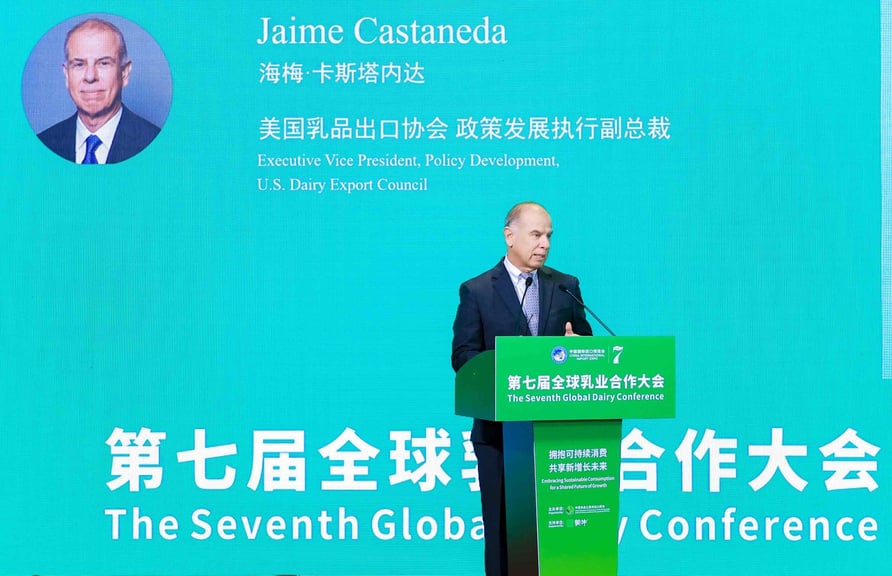
USDEC’s Jaime Castaneda reiterated U.S. commitment to the Chinese market.
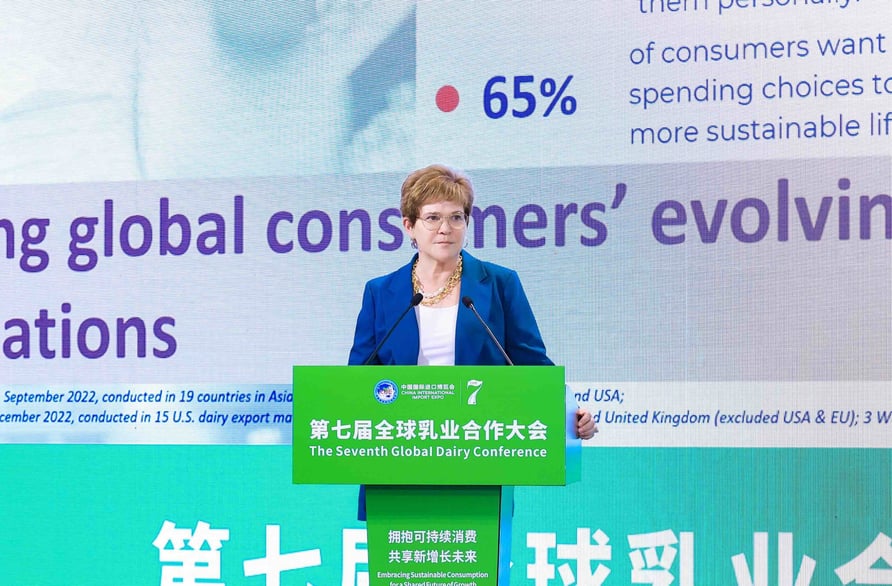
Harden’s presentation at the Seventh Global Dairy Conference focused on U.S. dairy’s extensive commitment to sustainable production, supporting healthy diets and advancing nutrition security.
What dairy trade might look like under new administration
With the presidential election concluded, Jaime Castaneda, writing in his role at NMPF, offers his opinion in Hoard’s Dairyman on how the Trump Administration may approach trade policy and what that might mean for U.S. dairy producers. To read the article, Click on, “What dairy trade may look like under Trump.”
Solid September caps a strong third quarter for U.S. dairy exports
Year-over-year (YOY) U.S. dairy exports jumped 8.5% in September in terms of milk solids equivalent (MSE), reflecting strengthening global demand in most regions outside of China. It was the third straight monthly YOY gain, yielding the United States’ best quarter for dairy exports since October-December 2022.
YOY U.S. export value jumped 18% to $715.2 million—the second-highest monthly value this year. The increase lifted the year-to-date (YTD) change in export value to +0.4%. That’s the first time YTD value has crossed into positive territory in 2024.
U.S. gains were widespread by both product and geography. Here are a few highlights:
- U.S. cheese sales recorded their ninth straight monthly YOY increase in September—+7%, +2,503 MT—driven by Mexico (+19%), Central America (+31%), South America (+60%) and the Caribbean (+26%). Year-to-date (YTD), U.S. cheese exports were running well above record pace for the year.
- Low-protein whey exports had their biggest month of the year, with volume up 15% to 46,307 MT. While China remains the top U.S. buyer (YOY September shipments +12%), Indonesia posted the biggest gain for the month—+3,731 MT—as volume more than tripled. YTD through September, U.S. low-protein whey exports to the world were up 8% (+30,173 MT).
- U.S. NFDM/SMP sales jumped 16% (+8,481 MT), driven by sizable increases to the two largest U.S. milk powder customers: Mexico (+23%) and Southeast Asia (+34%). In the third quarter, U.S. NFDM/SMP exports increased 8% compared to the previous year, cutting an 11% YTD deficit to just 5%.
For more on September trade numbers, including deep dives into Latin America and Southeast Asia, read the U.S. Dairy Exporter Blog story, “Strong September lifts U.S. dairy exports to best quarter in nearly two years.” In addition, visit the U.S. Exports section in the USDEC Data Hub and experiment with the interactive charts.
USDEC brings feed seminar back to China
On Oct. 25, USDEC held its first pig feed technical seminar in China in five years. The pig feed seminars are scheduled when market conditions suggest opportunities to increase U.S. whey permeate rations in piglet diets. With China’s pig sector slowly emerging from the bottom of a market cycle and with the 13th Leman China Swine Conference & World Swine Industry Expo taking place Oct. 25-27, the timing was perfect.
USDEC’s aim is to highlight how increased use of U.S. whey permeate can help the Chinese pig industry achieve better economic results. Seventy-seven pig sector professionals attended the half-day seminar to hear a line-up of expert speakers share their insights on U.S. whey permeate’s benefits on piglet performance and health. Speakers included:
- Daiwen Chen, Sichuan Agricultural University, who discussed piglet gut health and nutritional regulations.
- Sung Woo Kim, North Carolina State University, who reviewed recommended usage levels of whey permeate for the growth of nursery pigs, as well as the impact of whey permeate on a piglet’s gut health, microbiome and survivability.
- Guangkun Wei, technical director, Lewin Nutrition and Technology, who presented analyses of current use of dairy and whey products in nursery diets.
- Qingping Liu, director, Asia, International Ingredient Corp., who reviewed whey permeate processing and quality standards.
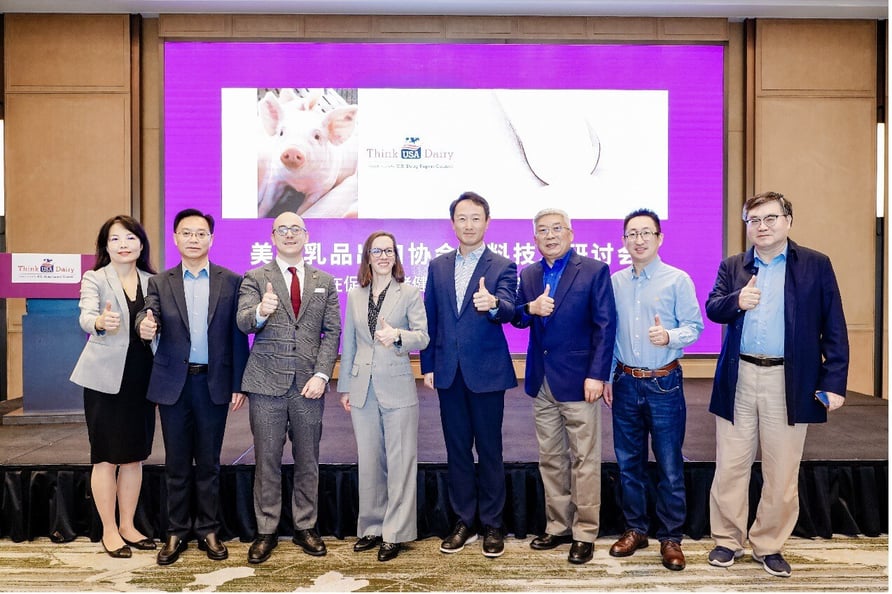
USDEC staff and speakers from the feed seminar. Left to right: Chang Su, USDEC China office; Daiwen Chen, Sichuan Agricultural University; Jadon Marianetti, Embassy of the U.S. in China; Annie Bienvenue, USDEC Arlington; Sung Woo Kim, North Carolina State University; Qingping Liu, International Ingredient Corp.; Guangkun Wei, Lewin (Beijing) Nutrition and Technology; and Zhiyong Pei, Embassy of the United States.
In addition to the pig feed experts, USDEC’s Annie Bienvenue, vice president, Global Ingredients Technical Marketing Services, presented opening remarks. Dr. Jadon Marianetti, agricultural attaché, Office of Agricultural Affairs, Embassy of the U.S. in China, welcomed attendees; and USDEC China office representative Chang Su moderated the event.
Five USDEC member companies also attended the seminar with tabletop displays to engage with participants. Interaction between speakers and the audience was lively, and 91% of evaluation forms rated the seminar as “excellent” (the other 9% called it “good”). All expressed interest in attending future USDEC seminars
Companies that attended that were not already using U.S. whey permeate in feed rations expressed interest in doing so. Three companies requested samples.
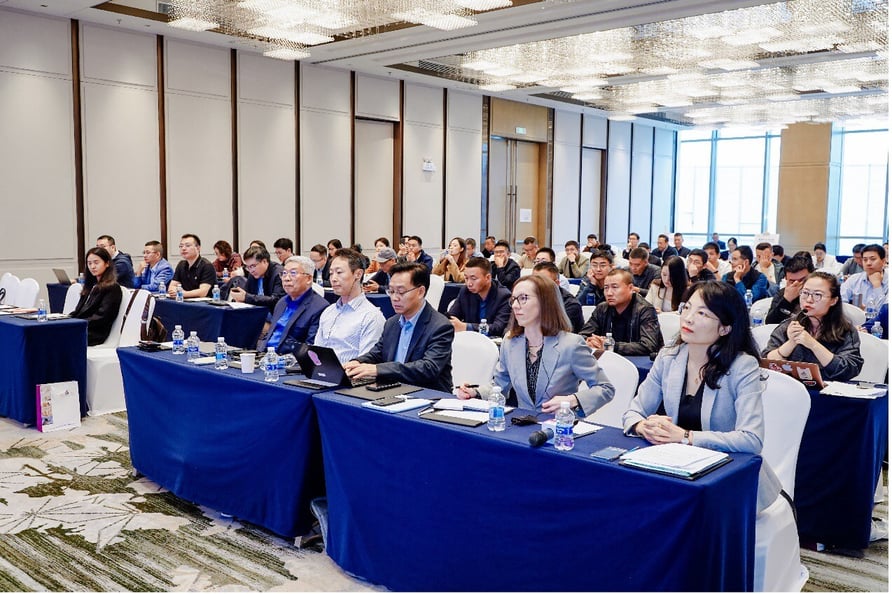
A full house of Chinese pig industry professionals flank seminar speakers and USDEC staff seated at the front table of the USDEC Technical Feed Seminar on Oct. 25 in Chengdu.

Dr. Daiwen Chen highlights factors influencing pig gut health.
Trends and outlook workshop outlines growth potential for U.S. dairy protein in Japan
A packed audience of 51 importers and procurement/purchasing staff from major Japanese food and beverage makers attended USDEC’s U.S. Dairy Protein Trends and Outlook Workshop on Nov. 5 in Tokyo. The event had two primary goals:
- Emphasize the bright future for protein-added mainstream health-and-wellness food and beverage products in Japan—and opportunities to innovate using U.S. dairy protein.
- Highlight that the United States is ideally suited to be Japan’s supplier of choice, given U.S. capacity expansion, the advantageous U.S. dairy protein ingredient product portfolio and U.S. dairy protein innovation expertise.
William Loux, USDEC senior vice president of Global Economic Affairs, and Ryosuke “Joe” Tanaka, country manager-Japan, Innova Market Insights, presented to the audience and also joined a panel session and Q&A moderated by Hisao Fukuda from the USDEC Japan office.
Loux outlined the substantial financial and physical investments the U.S. dairy community has been making in cheese and, in turn, whey production processing capacity. Those investments have the U.S. better positioned (vs. other origins) to supply Japan and the world’s future dairy growth needs—particularly with dairy proteins like WPC80 and WPI.
Loux allayed any concerns about lagging U.S. milk production growth this year, pointing out that recent U.S. supply growth constraints are due to temporary factors like limited heifer supply. By contrast, supply growth constraints in the EU and New Zealand are structural, such as regulatory challenges that inhibit dairy expansion.
Dairy proteins are also the focus of USDEC ingredient marketing programs in Japan. Together, those factors should give Japanese customers reasons to be confident in the United States as a source of supply as well as a source of protein knowledge and expertise.
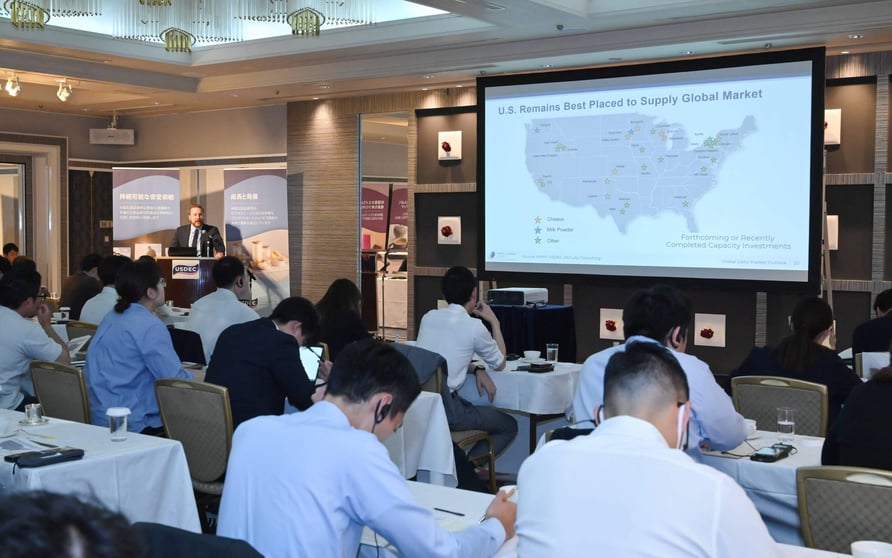
William Loux discusses why the United States is best positioned to supply global markets over the long term.
Tanaka’s presentation highlighted protein trends, business growth opportunities and implications for Japan. Despite data showing the protein market in Japan is expanding rapidly, he argued that the country is still at the beginning of the protein growth trajectory, with substantial upside potential ahead.
For example, Innova tracking showed that total food and beverage launches in Japan with “high in” or “source of” protein claims was only 2.3% in 2023. That compares to a global average of 6.3% and the United States’ number of 10.9%.
Tanaka outlined five areas that could accelerate the growth of U.S. dairy proteins in Japan.
- Diversify protein options beyond sports nutrition and powders to everyday mainstream food and beverages.
- Differentiate dairy protein to consumers by highlighting protein quality (as opposed to quantity), a strategy that is particularly suitable for aging populations that just can’t eat large volumes of protein.
- Help consumers navigate smart and easy protein consumption opportunities to offer more eating occasions, such as by creating more Japan-friendly products that can be consumed anytime, anywhere, or products to fill current protein gaps, such as breakfast-positioned items.
- Tailor protein products for specific needs, such as for older adults and women.
- Enhance sensory appeal and excitement: Consumers in Japan pay close attention not just to health, nutrition and taste, but also texture and other sensory attributes for them to feel satisfied or experience indulgence.
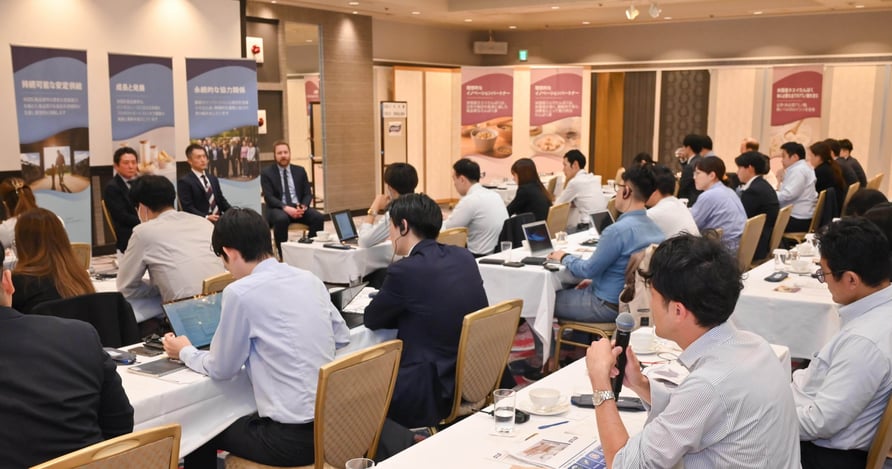
On stage, left to right: Hisao Fukuda, Joe Tanaka and William Loux answer dairy protein questions from workshop attendees.
USDEC continues Colombia ingredients workshops
USDEC’s Colombian dairy ingredients workshop series continued last week in Ipiales with the training session, “Applications of Powdered Ingredients to Optimize Dairy Product Formulations.” Professor John Jairo Ortiz from the Universidad de Antioquia led the training, which focused on the benefits of using U.S. nonfat dry milk and MPC in yogurt and campesino cheese (a lightly pressed, fresh, salty cheese often used as a topping).
Nineteen Latin American food professionals and students attended the event, which combined classroom and hands-on instruction to provide insights on U.S. dairy ingredient functionality, versatility and application potential in products common to the region. Participants included representatives from notable processors such as Colacteos and Lácteos la Delicia la Frontera.
This is the third workshop in Colombia over the past three months, with two more scheduled for late November. The events have garnered a strong positive response from local processors eager to learn more about the benefits of using U.S. dairy ingredients.

John Jairo Ortiz (right, holding whisk) demonstrates how U.S. nonfat dry milk and MPC can be used in yogurt making.
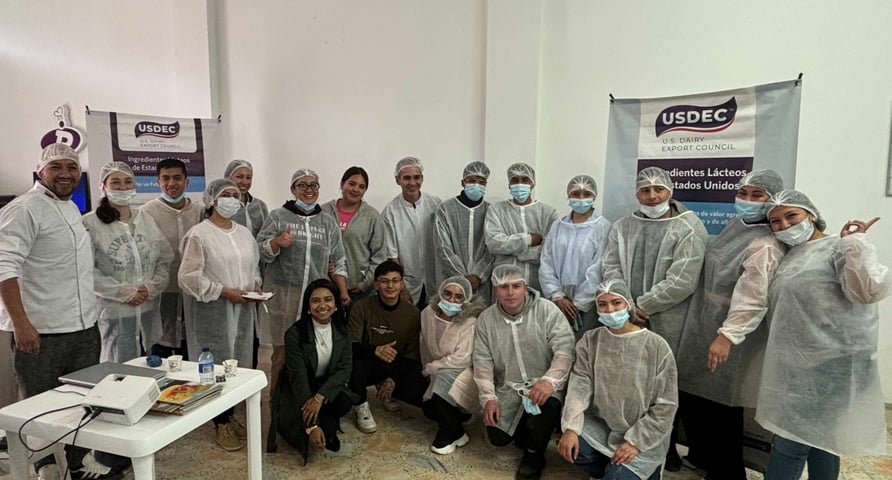
Participants pause for a photo during the latest U.S. dairy ingredients workshop in Colombia.
USDEC meets with U.S. trade officials about common names
Last week, USDEC’s Jaime Castaneda and Shawna Morris, in their leadership roles for the Consortium for Common Food Names (CCFN), met with USTR Ambassador Katherine Tai, Chief Agricultural Negotiator Doug McKalip, and key USTR staff on the topic of common food names and the ongoing threat posed by the EU to monopolize those names. (CCFN was founded and is staffed by USDEC.)
USDEC thanked Ambassadors Tai and McKalip for their leadership during the common names negotiations with Chile, and for their ongoing work in Asian and African markets. But they also discussed the urgent need for USTR to adopt a stronger, more permanent approach in proactively defending common names, including how to leverage the United States’ economic and political leverage when common ground is hard to find.
Given the intricacies of the issue, defending common names must be a joint priority across agriculture and intellectual property to secure U.S. market access rights, Castaneda and Morris explained.
Former Representative Ron Kind, a longtime champion for common names, joined CCFN for the meeting, underscoring the immediate need for more urgent action against the EU’s aggressive widespread confiscation of common names. He also emphasized the strong support in Congress for defending common names on behalf of U.S. producers.
USDEC highlights common name concerns in Europe
USDEC’s Shawna Morris outlined the U.S. position on common food names and sought to cultivate common ground on future solutions with the EU dairy sector at this week’s Lacto Law Day conference in Berlin. The conference was run by the German dairy association, Milch Industrie Verband (MIV). Morris highlighted U.S. support for legitimate geographical indications (GIs) and how that is distinct from protection for common food names in her presentation, “GIs and Generic Names: Finding Simple Solutions to a Contentious Topic.”

Left to right: Outgoing MIV Executive Director Dr. Joerg Rieke; USDEC’s Shawna Morris; and Werner Giselbrecht, Hochland Deutschland.
Events
USDEC cheese mission to Central America in March 2025
USDEC invites members to participate in a cheese mission to Central America slated for March 17-25, 2025. The mission will include activities in Guatemala, Costa Rica and Panama. Day 1 in each country will consist of a market briefing and retail tour for U.S. suppliers to glean information about cheese opportunities. Day 2 will include a seminar for the local trade (importers/distributors, retailers, foodservice operators, food manufacturers and other end-users). One-on-one meetings between U.S. supplier participants and pre-qualified purchasing decision-makers from cheese-buying companies will follow.
The conclusion of the mission coincides with the start of the Expocomer trade exhibition, March 25-27, in Panama, providing U.S. suppliers an optional, additional opportunity to connect with the Central American trade.
Background
Central America is a strong, traditional dairy-consuming market, but only about 40% dairy self-sufficient. The U.S. enjoys both favorable logistics and a tariff advantage as duties phase out according to the Central America-Dominican Republic Free Trade Agreement (CAFTA-DR) and U.S.-Panama Trade Promotion Agreement.
U.S. cheese suppliers have made significant inroads in Central America over the past five-plus years. U.S. export volume to the region rose 66% (+17,806 MT) from 2019-2023 and was up another 20% through the first nine months of 2024.
Through three quarters of this year, Guatemala was the No. 6 cheese export country for U.S. suppliers. Panama was No. 8, the Dominican Republic was No. 9 and Costa Rica was No. 14.
Suppliers are responsible for their individual travel and lodging costs for the trip, but the mission is otherwise free of charge. Covered costs include meeting venues, tours and receptions, group ground transportation, group dinners and a consolidated cheese shipment.
Members interested in the mission should click here to sign up by Nov. 29, 2024. Questions should be directed to Hyebin Kim at hkim@usdec.org.
Market Summary
GDT prices jump
The Global Dairy Trade (GDT) Price Index jumped 4.8% at the Nov. 5 auction, with healthy gains for nearly every product. An increase was anticipated based on GDT Pulse results and futures activity prior to the auction, but overall buyer enthusiasm exceeded expectations, particularly on fats. Prices increased for all contract periods for WMP, SMP, AMF and butter. Cheddar prices rose across all contracts except Contract 1.
North Asia (China), which has been regaining its GDT appetite in recent months, looked like its old self, bidding up prices and leading purchasing in WMP, SMP, butter and AMF. While it bought less overall than the previous event, China was the clear market mover, with some help from the Middle East, which topped cheddar buying and was among the leaders for butter and WMP. (The Middle East acquired 17% of total volume sold—a significant increase from 10% at the previous auction.)
The gains came despite solid growth in September milk output in New Zealand and rosy predictions for a strong peak. Weaker milk output in Europe, South America and China, shrinking Chinese inventories, and solid demand in key markets were behind the price hikes.
The biggest increases came in butterfat. The average winning butter price jumped 8.3% to US$6,990/MT, the highest price since mid-June. AMF rose 4.6% to a new record-high of US$7,558/MT.
WMP increased 4.4% to US$3,713/MT, the highest price since September 2022. SMP rose for the first time in the past three auctions, gaining 4.0% to US$2,850/MT.
Cheddar posted its fifth consecutive price rise: +4.0% to US$4,973/MT. Mozzarella stabilized after a sharp run up and even sharper decline from late July to mid-October. The average winning price inched up 0.9% to US$4,607/MT.
Russia runs into butter troubles
Disrupted supply chains due to wartime sanctions are causing problems in the Russian butter market. While tight butter supplies and strong demand have lifted butter prices globally, Russia is dealing with the additional issue of its war in Ukraine. An estimated one-quarter of Russia’s butter is sourced from abroad, but disrupted supply chains related to wartime sanctions from traditional suppliers like New Zealand and Latin America have caused butter prices to jump more than 25% this year.
Russia is seeking new butter suppliers to fill the gap. In late October, it began importing from Turkey and this month received its first-ever shipments from the UAE. It has also proposed a temporary tariff waiver on butter for the countries of the Eurasian Economic Union (Russia, Belarus, Armenia, Kazakhstan and Kyrgyzstan). In addition, Russian government officials reached an agreement with local butters processors to track their butter output with an eye toward ensuring sufficient supplies. (USDEC Middle East/North Africa office; Bloomberg, 11/1/24)
Market Access & Regulatory Affairs
USDEC makes 200+ Export Guide document updates in October
The MARA team updated or revised more than 200 documents in the USDEC Export Guide last month. Here are some highlights:
Volume 1: Tariffs and Classification
- Brazil: Noted that HS 0406.90.30 (other soft cheese of a moisture content, by weight, of 46% or more but less than 55%) MFN temporary tariff increase (of 2% to 18% total) ended and decreased to standard 16%.
Volume 2: Import Requirements
- Brazil: Updated information about manager user/credentials in the MAPA online system for label registration.
- Chile: Updated FDA plant list and the month of last update, as well as the approved monograph list for product registration.
- India: For the India Model Health Certificate, updated links to the DAHD website following site redesign.
- Malaysia: Under U.S. Dairy Plant Registration or Approval, added new links to the approved dairy facility lists and added requirements for submitting registration documents to DVS.
Volume 3: Labeling and Product Standards
- China: Added the new standard for food additives, which enters into force Feb. 8, 2025.
- GCC: All compositional standards were modified in regard to trans fats in foods; additionally, the standard for salt limit guidelines was updated and affects cheeses, butter, and laban. Complete revisions for the following standards were performed: Butter, Danbo Cheese, Fermented Milk, Gruyere Cheese, Sterilized Milk, Trans fats in Foods, UHT milk, and Yogurt (see fermented milk standard).
- Japan: List of accredited labs updated Sept. 30, 2024 (added new link to all compositional standards).
Every month, USDEC’s Market Access team emails a list of guide updates to interested members. If there is anyone at your company who should be included on the distribution list for that email in the future, please contact Jessica Smith at jsmith@usdec.org.
Company News
Glanbia announces separation of Glanbia Nutritionals business
Ireland-based Glanbia announced a change in its operating model that will separate its Glanbia Nutritionals business into two new segments: Health & Nutrition and Dairy Nutrition. The Health & Nutrition segment will incorporate Glanbia’s premix solutions and flavors platforms. The Dairy Nutrition segment will focus on cheese and dairy ingredients and will comprise the portfolios of protein solutions (which are currently in the Nutritional Solutions segment) and U.S. Cheese. It will also become the commercial partner for the Group’s joint venture MWC-Southwest Holdings LLC.
Glanbia CEO Hugh McGuire said the new structure is designed to streamline the business further, sharpen its focus on end-use markets, and position the company for the next phase of growth. Glanbia expects to implement the new operating model during FY 2025, with more details to be provided in early 2025. (Company reports)
Mergers, acquisitions and joint ventures
U.S. kefir maker Lifeway Foods rejected an unsolicited offer by Danone to buy the company. The Lifeway board “determined that Danone's opportunistic proposal substantially undervalues Lifeway,” the company said in a statement. … Chicago-based dairy and dairy-free flavor manufacturer Edlong Corp. announced the acquisition of Brisan Group, a Chicago-based market research and product consultancy firm. (Company reports)
In Case You Missed It...
U.S. Dairy Exporter Blog
Market analysis, research and news subscribe hereUSDEC Twitter feed
Follow us here.